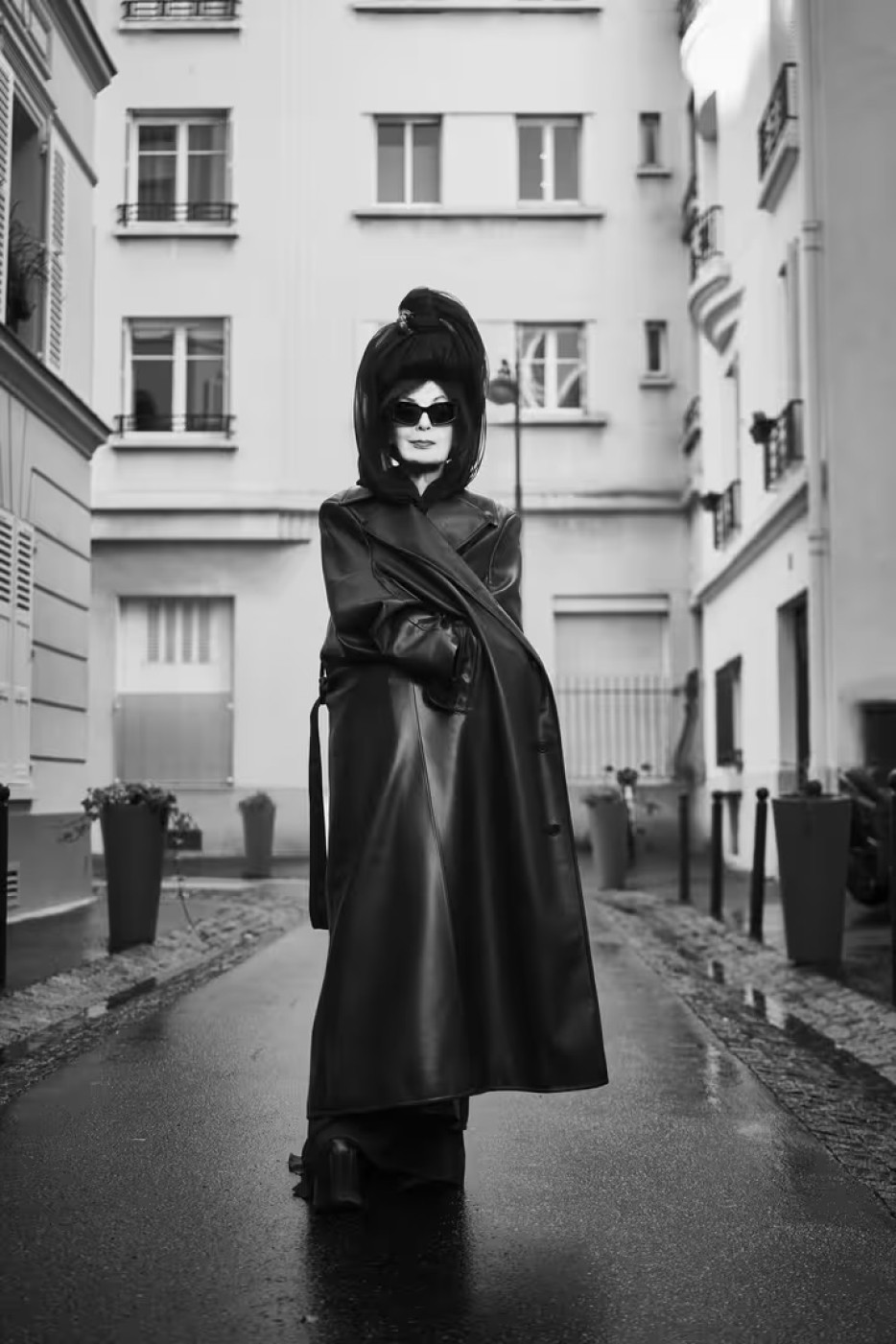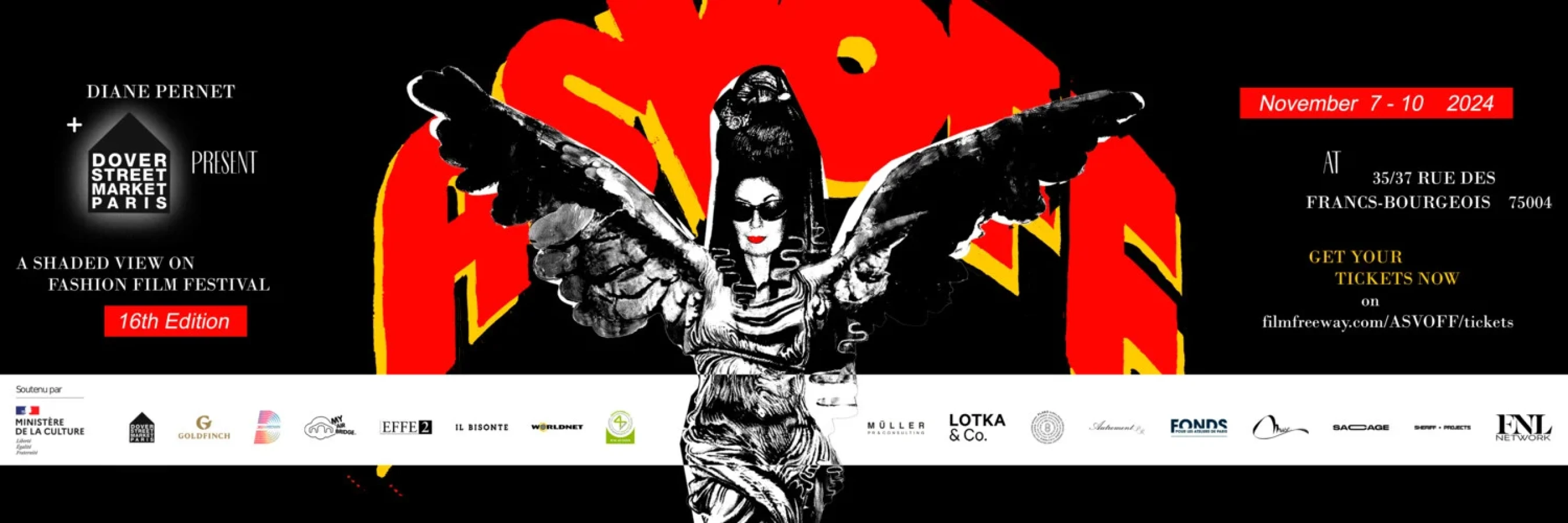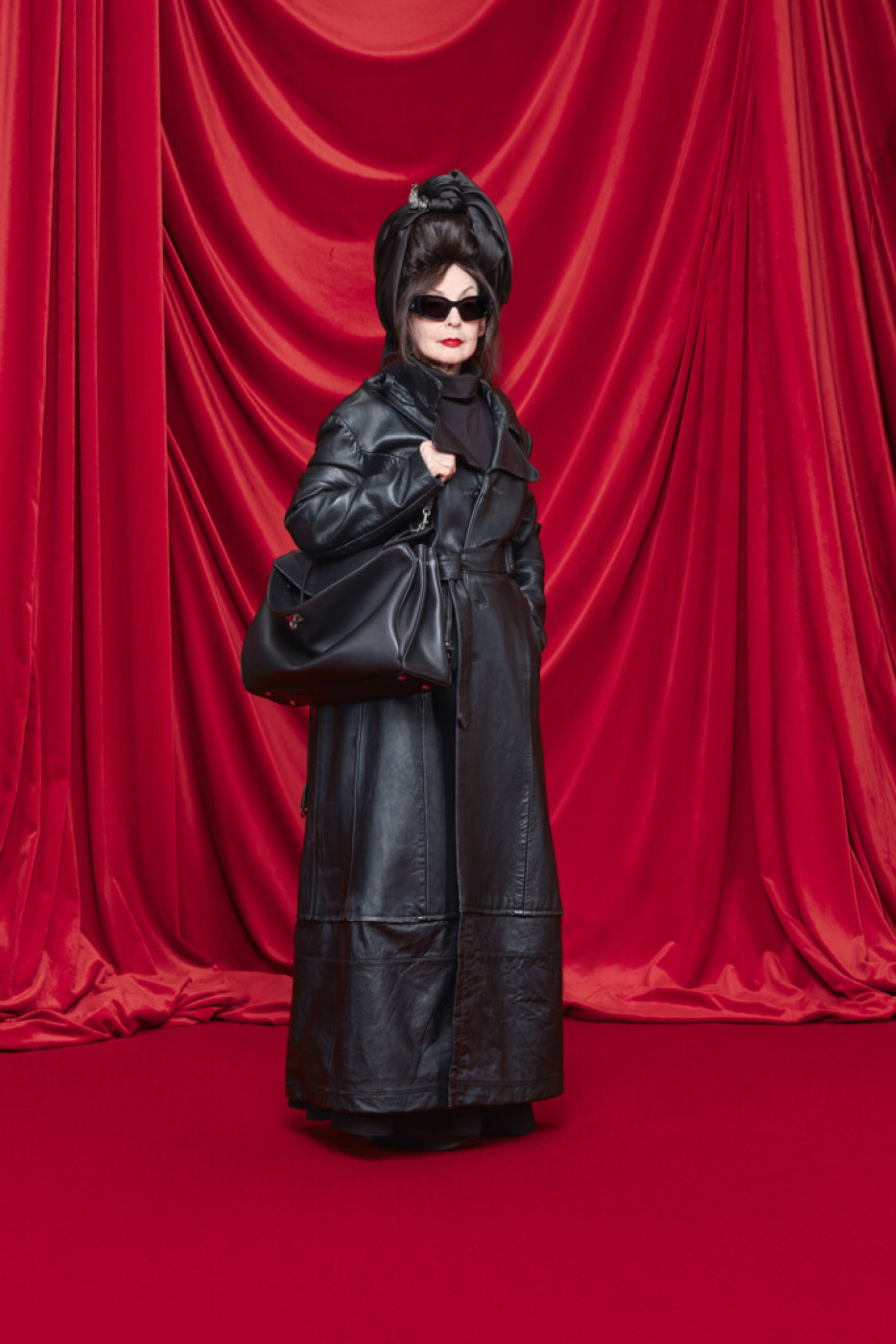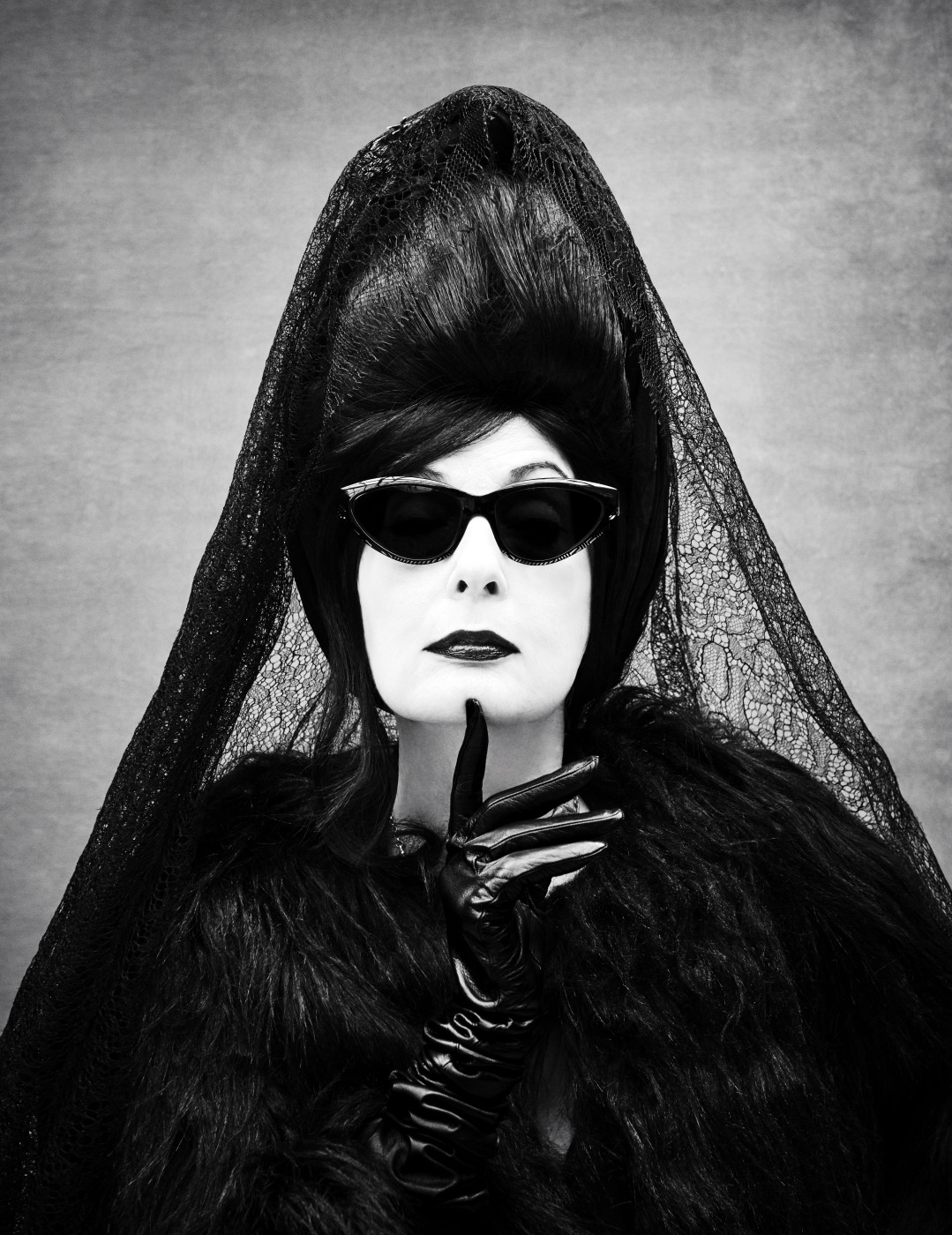

ASVOFF: Diane Pernet on her Vision of Fashion and Film
The best word to describe Diane Pernet is icon. An American fashion insider with a signature style (you will never miss her if you cross her path), and a New Yorker, she found her place in Paris, where her fashion film festival ASVOFF (short for A Shaded View On Fashion Film) takes place at the newly inaugurated Dover Street Market in Le Marais district over one weekend from November 8 to 10. Ahead of the 16th edition of the festival, Diane met us at her favourite brasserie in the 7th Arrondissement in Paris, where we had a candid conversation about fashion business and cinema, what it really means to follow your dreams, making things happen, and why it’s so important to shine a light on the talents in the shadows.
It’s the 16th edition of ASVOFF. How did you come up with the idea of the festival?
My first fashion film festival was in 2006 in Los Angeles, and it was called “You Wear It Well”. I took a line from Rod Stewart’s song, I didn’t own that. Paris is known for fashion, but LA is really not. So, I thought let’s give them some fashion and they were up for it. That’s why it started there. I always wanted to do a fashion film festival, but there weren’t enough films. It was not a genre like right now. Then, when Mark Eley of Eley Kishimoto commissioned me a road movie in 2005 for the launch of his menswear collection (the only one they ever did via the Gumball Rally), I made him a 18-minute film. It was before YouTube, it’s like Ancient History!But I didn’t want to just show my film, so I said: “Let’s have a film festival!”. I took some films from SHOWstudio and Bruce Weber. At the beginning, there were just two of us - me and my blog contributor from LA, but we made it happen. In 2008, since I was already living in Paris, I had a proposal from the Jeu de Paume museum. That was when I decided to change the name of the festival (as you see, it didn’t work out well with my LA partner as I thought it would, naturally) - I had to come up with a new option very fast, so it was A Shaded View Of Fashion for my blog and A Shaded View Of Fashion Film for the festival. Also, ASVOFF started as a travelling fashion film festival. I still love to travel, but a lot of places we have been to have started their own festivals. This is the fourth year we are at the Dover Street Market location (before it was used as a purely cultural space 35-37 - ed. note), where my festival has finally found its home. Before we were at Jeu de Paume for a couple of years and Centre Pompidou for seven years, and even homeless for a while (laughs).

You receive so many candidates. How do you tell if it’s a good movie?
It should provoke an emotion. You should feel something when you watch a film. But it’s very diverse, it’s like comparing oranges and apples. It’s also instinct, nothing more than that, if I feel something or not. We always try to limit our main festival program to 30 films, even if we had more before. Also, we have eight categories, where I choose a curator and they choose their jury. For example, this year I asked Florian Müller to come up with a selection for the Mental Health in Fashion category. He is really good at it! Mental Health is his speciality, Florian has been studying it and practising it. This is what he cares about, it’s really valid. Look, at the fashion industry, we need to ask these questions. We wanted to raise awareness and destigmatise mental health issues in the industry. We also have an AI-generated films category curated by Pedro Guez and Daniel Face. And the year before we had TikTok, I thought they might be interested in sponsorship, but they are only interested in sports (laughs). It was fun, but now I feel that AI-generated films are more relevant. Some themes stay relevant for a long time, and others change. For example, the Black Spectrum stays, and so do the Chinese films, it’s important to shine a light on those talents who need it.
Why did you integrate Chinese films into your program?
I had it at ASVOFF for more than ten years now. China has a new generation of talents, it’s not about copying anymore, it’s about expressing themselves. In the beginning, people did not give them so much attention, but I always found it interesting. This time, there will be a talk by Tim Yip, a very well-known Chinese director and the first Chinese to get an Academy Award for Costumes and Art Direction for “Crouching Tiger, Hidden Dragon” (2000). We have known each other for a while now. I met him in China, he has done costumes and art direction, and I asked why don’t you make a film for my film festival? This was probably eight or nine years ago, and he made his first film when we were at Centre Pompidou for ASVOFF 7. I loved his film, but nobody responded to it. The next year he put in a film called “Kitchen”, it was about a preparation for the Emperor’s meal. It was beautiful, and it was the year when Jean-Paul Gaultier was the jury president and this film won the Best Art Direction award.
Are you planning to expand to other markers?
Yes. I would love to expand to the Middle East. It was in the works last year, but it didn’t happen. So why the Middle East? The only time I was in Dubai, I met this amazing woman Butheina Kazim, who has an independent cinema there, Cinema Akil. She was one of the best interviews I ever had, and I asked her if she would love to be on the jury when Gaultier was our president, and she said yes. She had local government support to cover her travel expenses and she was great. But it’s always hard to organise this type of partnership, you have to have government support to cover the costs of bringing international people in. ASVOFF is an association, it’s built on love. We have to figure out a way to make it happen next year.
I feel like today, it’s often jewellery and fashion brands that support independent cinema. Miu Miu gives the floor to women’s directors for their project Women’s Tales, Saint Laurent produces movies, and Loewe has a partnership with Luca Guadagnino.
More now than ever, isn’t it? I prefer to have angel investors and sponsors, who are not going to say anything about the content. For example, one of our main partners is Worldnet, a luxury shipper for art and fashion. And it’s perfect. Or Samsung and Renault, which we had before when the festival was taking place at Centre Pompidou. I wouldn’t mind Saint Laurent, and I quite agree with Anthony Vacarello’s taste in film, this is exactly my taste, but I don’t have his budget (smiles). You have to be very attentive who you create partnerships with. Look at what happened to the Cannes Film Festival, it’s not about the movies anymore, now it’s all about promoting what the actors are wearing. They don’t care about the films. They walk the catwalk, they get the picture taken and they never stay until the end of the movie. You know, if you have a ticket, and you don’t go, you will be blacklisted in Cannes, so people go and leave the movies. It’s horrible, why are you there? And so many people go to Cannes only for parties. When I ask them, what films did they see? They answer nothing, they didn’t see anything. It’s sad.
So, what other types of partnerships do you have?
We have a local partner called Fonds des Ateliers de Paris pour les Métiers de la Création. They support French artisans, and it’s quite an interesting partnership, because we asked one of their artisans to make the Grand prize for us in Bronze. Her name is Chloé Valoroso, she is so talented, she is absolutely amazing. We have a small accessories brand Il Bisonte, as well, they have been there for a couple of editions. It’s not always about money, we are now working on a Board of Directors so that they can make the ASVOFF more visible. Artist Alejandro Jodorowsky is already on board!
You also asked Michèle Lamy to head the jury for this year's edition. How do you select the jury team?
Michèle was my president 10 years ago, so that’s her second time. Last time, she met film director Matt Lambert at the festival. His first fashion film was for the British Fashion Council, and he won the award when she was the president. And later he did a couple of films with Michèle. This year, Matt will also be on the jury. That’s the nice thing about our festival: people meet other people, exchange and find common ground for creative partnerships. Same goes for Jessica Mitrani, Colombian director based in New York, who won an award years ago at ASVOFF, when Rosy de Palma was on the jury, and they have done all these films together. Who else is on the jury this year? We have German costume designer Bina Daigeler, who did costumes for Almodovar’s film. We also have Swedish singer Jay-Jay Johansson, French photographer and filmmaker Sylvie Lancrenon, American actor Harry Goaz, French pop star Loane, artistic duo Fecal Matter (they are launching their fashion brand next March, they’ve got everything to be a big success, stay tuned!) and Parisian opinion-maker and content creator Elias Medini aka Ly.as. He will be the co-master of the opening ceremony with Michèle. I love his reflection, his commentary is always on point. It’s a real mix, I love picking jury members from a variety of industries, cultures and ages, with different backgrounds so that they can all have different views on the films.

You are a fashion icon. Tell more about yourself, where does your passion for films and fashion come from?
I am considering myself as an insider outsider. I want to be away from all the toxicity of the industry, I don’t want to be a part of that bitchiness. Some people make everything difficult, that’s just life. I am here because I love creation. I am curious and I love to be surprised. And I love fashion and film, obviously. I always wanted to be a fashion designer, but I was also in love with movies. In those days, I wasn’t reading fashion magazines, I was reading movie magazines. From the first drive-in movie I saw, I was totally enchanted with cinema. I got my degree in film-making, and then I went to fashion a couple of years later. I always loved both cinema and fashion, that’s why I put together the fashion film festival, it was like completing the circle, mixing together two things I love. I love creation and beauty, fantasy and reality. I love documentaries, because they are real or can be (laughs). Who knows? With AI it’s quite scary, because we never know what is real.
How did you end up in Paris?
I come from New York. And, to be honest, New York in the 80s was depressing. Everything changed so much from 1987, when AIDS came and killed 80-90% of my neighbourhood, the economy was bad, homeless people were living in boxes in Tompkins Square Park. And I thought as a fashion designer, which I was with my own brand, it is not inspiring. If I want to stay in fashion, where can I be? Paris, London or Milan? London for Anglo-Saxons is not that exotic, even if I love the British people. And I love Italians, as a culture it’s one of my favourites, but I am not crazy for Milan. So I moved to Paris thirty-four years ago with no plan, and I am still here. I have never been anywhere else this long.
You are known to be one of the very first bloggers: how did you transfer from designing to fashion reporting?
When I moved to Paris in 1990 I did so many different jobs. I did costume designing and I also worked for Canadian Broadcasting Company (CBC), as an assistant producer with Tim Blanks. We knew each other from the times when I was a designer and he used to live in Toronto, and I did a trunk show there. Then I worked at ELLE.com and Vogue.fr as a journalist, when Tina Isaac-Gouzé set it up. We both lived in the 7th Arrondissement in Paris, that’s how I met her, and I wanted to do video. She was also my boss at ELLE, where I had a style column “Doctor Diane”, where they did a drawing of me with a camellia, so I looked more like Coco Chanel than me. It was funny. My video blog was a bit of a different affair because I was putting spotlight on young designers, back at the time there were three bloggers: The Satorialist, Cathy Horyn and me. I used to use this gadget called The Flip, it looked like a phone, but it could only take video recordings, and you could immediately upload it on your blog. When the iPhone came out, it killed The Flip. Now, I film everything on my phone. That’s life, moving right along.
Did you already have your signature style at the time?
I didn’t look very different, the veil maybe was missing, but I always dressed in black and dark blue. And now I am gonna shock you, if you run into me this winter. My friend Donald Schneider, who used to be the Art Director of French Vogue under Joan Juliet Back and was in charge of fashion collaborations at H&M for many years, is bringing back a German heritage outdoor brand ELHO, and he made me try on a neon green jacket. I am in love with it.
What have been the best fashion moments you lived through recently?
When I walked the Balenciaga catwalk, it was fun. Even if I am not a model-size, and I am very shy, I am so happy behind the scenes always and forever. Everybody was so sweet, except for Anna Wintour, who came backstage before the show and didn’t say a hi (when I was a designer, she made several pages on my brand). There was such a beautiful energy, the casting person was telling us how to walk, the make-up artist was fantastic, everybody there was great. And there was also Demna’s mum. Actually, just like me, she is not tall at all, and she told him that if he wants to have her model, he would need to put the catwalk up, so that people would watch us walk from a distance and everybody would seem tall. Walking at Balenciaga was the best PR I ever had in my life. How did it all happen? I remember I received a text message from Demna during summer, saying that he wanted to have people that had an impact on his life at the show. I was there because I gave him his very first press and believed in him. I was in his jury when he was graduating from the Antwerp Royal Academy of Fine Arts. My colleague Rebecca Voight was doing research on Belgian designers at the time, and she told me that I can’t miss it. Fun fact: Glenn Martens (creative director of Diesel - ed. note) was modelling for Demna, he was a year under him. So, I liked Demna’s graduate collection and I said at the end of my post: “Head-hunters, this is the one to watch”. I had a good eye (smiles). It was the same with Anthony Vacarello, when I saw him at the Hyères Fashion Festival, he had just finished La Cambre fashion school in Brussels, and I looked at his clothes, and I said this is the one.

Who are the most exciting young talents on your radar right now?
I think ALL-IN is really good, it’s a designer duo, Bror Auguest is Swedish and Benjamin Barron is American. Their show was great, even before Lotta Volkova started helping them with styling. I remember their first show at Dover Street Market space. I met Benjamin through his mother Jeanette Montgomery, a famous photographer, she did books on Cindy Sherman and Jean-Michel Basquiat, and his father has a gallery for Outsider Art. One day we were having tea at my place. She wanted to take my picture, and she said that I should meet her son and see his collection. For me he is one of the most interesting designers right now. Vaquera are really great too. You feel that it’s authentic. They feel their market. It’s really good.
Is there something you miss in Paris from the US?
I wouldn’t say so. But when I moved here, I did not go back for seven years. And when I finally went back to the US for holidays, I didn’t realise until then that the only thing I missed was people smiling. It’s like you get there, and suddenly people are smiling at you. In general, Americans have a more positive attitude. It’s not like the first thing that comes out of their mouths is a “no”.
What are your favourite Parisian places? Where can one spot you most often?
Here, at Café de Mars, because it’s around the corner. You can also see me at Les Deux Abeilles on Rue de l’Université, Ihave my tea there. And then for Japanese food, it’s Yen on Rue Saint-Benoît or Toraya by Concorde, they are my favourite ones. I see my friends at Saint-Paul a lot, and I am happy in my neighbourhood close to the Eiffel Tower.

Courtesy: ASVOFF
Text: Lidia Ageeva

